The Scott Genius has been around since 2004 and it’s changed a heck of a lot since then. This latest version is a completely different beast to what went before. And that’s no bad thing.
The geometry, which was always too conservative for my tastes, has been stretched out to relatively radical proportions. The soggy single-pivot suspension is also gone, in favour of a supportive and progressive Horst-link design.
It can now accommodate both 29" and 650b wheels, shod with up to 2.6” or 2.8” tyres respectively. It’s got even lighter, too, making it one of the lightest 150mm trail bikes around.
Smart suspension
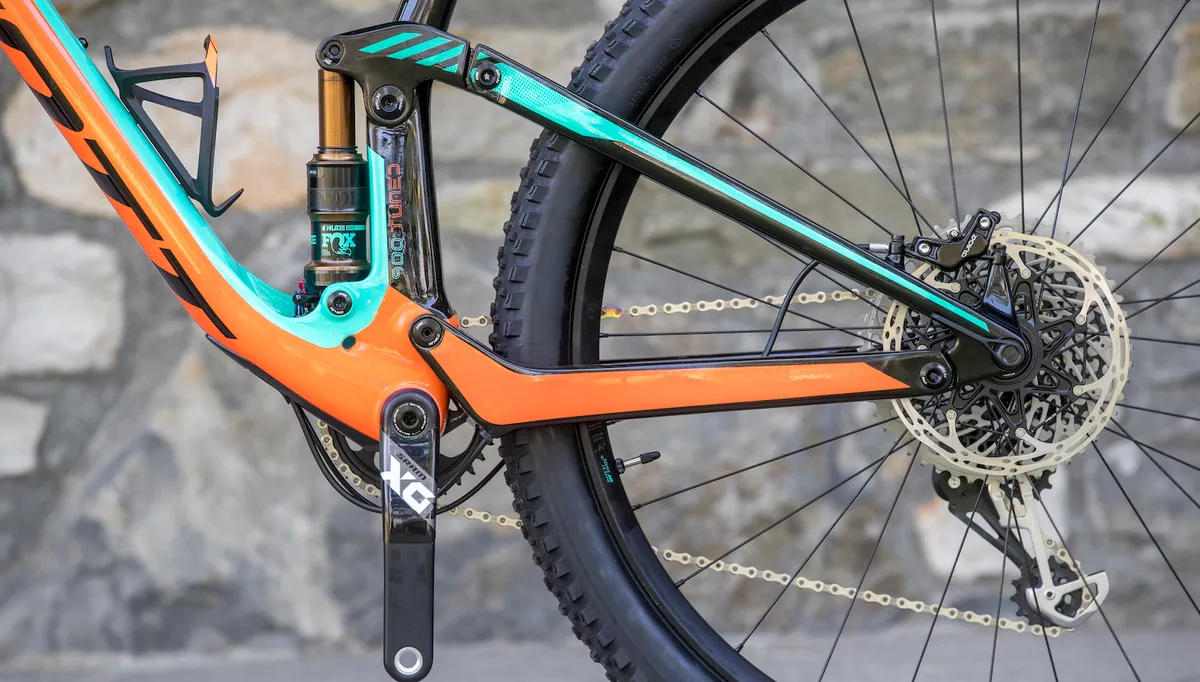
The old Genius used a linkage-driven single pivot (“faux-bar”) design, which had a habit of ploughing through the mid-to-end stroke far too easily.
In a first for Scott, the new Genius uses a Horst-link (four-bar) layout. This results in improved pedalling efficiency, while keeping the suspension a little more active under braking.
More importantly, the new design offers far greater mid-stroke support. The stroke starts off supple to sit you into the travel and the progression builds throughout the travel to prevent wallow.
Scott still uses its ‘Twinlock’ system. This offers three modes for different terrain at the touch of a bar-mounted leaver.
The first mode is fully open, offering 150mm of travel. The second ‘traction’ mode closes off part of the shock’s air chamber, resulting in a more progressive, supportive spring curve with 110mm of travel — this is said to hold you up higher in the travel and prevent wallow on steep climbs. It also firms up the low-speed compression damping on the fork and shock, but still allows some movement. The third mode fully locks out the suspension front and rear.
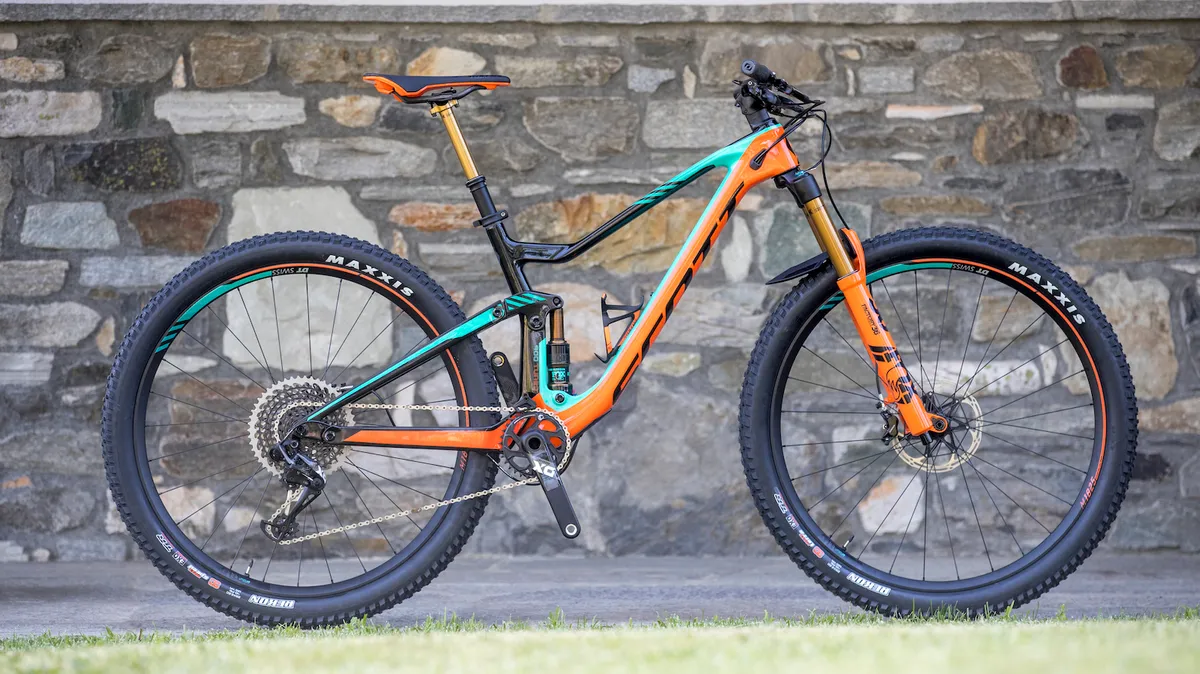
The Genius will be sold with either 29” or 650b wheels. There’s room to fit up to a 2.6” tyre with 29” hoops, and up to a 2.8” tyre in 650b. There is a caveat to that, though: a 2.8” tyre from Maxxis will fit in fine, but the Maxxis rubber fitted to the 650b wheels actually measure up closer to 2.6” wide.
Schwalbe’s 2.8” Nobby Nic on the other hand, is a little too wide to fit in comfortably. According to Scott, for a 650b wheel the maximum tyre width that fits in comfortably is around 65mm.
Inspired geometry
In order to work with different wheel sizes without changing the bottom bracket height, there’s an offset chip on the shock mount to adjust the bottom bracket drop by around 7mm.
According to my measurements, the BB sits at around 335mm in the high setting with the 650b wheels. For a 150mm travel bike, that’s properly low.
The Genius frame is carefully constructed from almost 900 pieces of high-modulus carbon fibre, resulting in a claimed frame weight of just 2,249g
I also tried out the low setting with the smaller wheels, resulting in a BB height of about 328mm. That’s probably a little too low! With the bigger wheels, the BB sits at around 340mm in the low setting.
Aside from the suspension, my main gripe about the previous Genius was its fairly conservative (short and tall) geometry. The new bike is a welcome and dramatic departure from this.
Tim Stevens, Scott’s MTB engineer, spent a lot of time riding Nicolai’s Extra-longest Geometron before finalising the Genius’ geometry numbers. As a result, some of that Geometron DNA has found its way into this bike.
For a start, the head angle sits at 65 degrees in the low setting and 65.6 degrees in the high mode. Though still steeper than the Nicolai, that makes it one of the slackest 29er compatible trail bikes from a mainstream brand.
The Medium has a reach of 445mm (in the high setting), while the XL measures 505mm. So the cockpit is very much on the longer side of things, especially in the bigger frame sizes — the range of reach figures is nice and broad across the size-range. That’s great news for taller riders.
I measured the wheelbase of the XL bike at 1,275mm, which makes it significantly longer than anything offered by most mainstream brands (Nicolai and Pole notwithstanding).
While the front-end has got longer and slacker, the rear-centre (chainstay length) has got shorter compared to the old Genius. It now measures in at a fairly tight 436mm.
I asked Tim Stevens about the rationale behind this. He explained that the super-long back-end on the Nicolai made it slower to lift the front wheel, so he wanted to keep the Scott’s chainstays short for easier manuals and a more “playful and responsive” feel.
Weight watcher
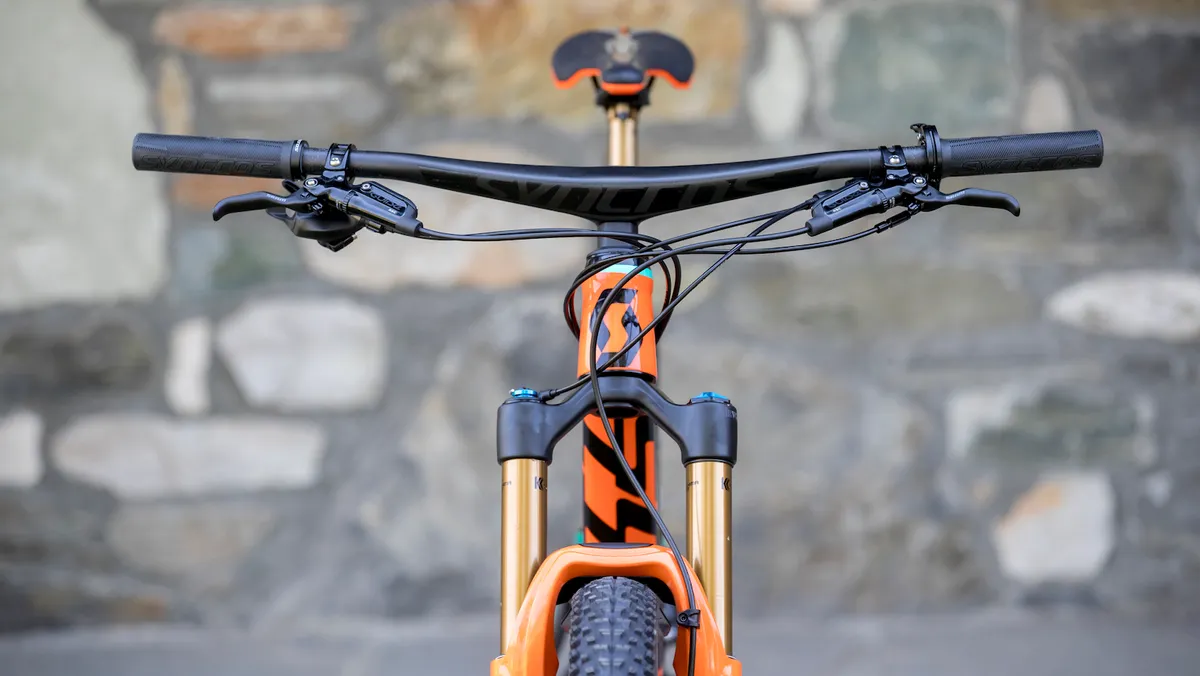
Lightness remains a key selling point for Scott. The Genius frame is carefully constructed from almost 900 pieces of high-modulus carbon fibre, resulting in a claimed frame weight (which I checked) of just 2,249g — that’s for a size small, with shock and hardware, but no rear axle.
I also weighed a complete bike, a size XL Genius 700 Tuned — which has 27.5” x 2.8” wheels, a Fox 36 fork and alloy wheels — at 12.45Kg without pedals. So it’s one of the lightest bikes of this travel, as well as one of the longest.
Some of that lightness comes from an innovative one-piece carbon bar and stem from Syncros. The HIXON iC bar is said to have the same geometry as a standard Syncros 760mm bar with a 50mm stem: it sports 9 degrees of backsweep and 12mm rise.
At a claimed 290g (that’s lighter than many handlebars), it’s significantly lighter than a traditional bar and stem combo, though less adjustable.
Ride impressions
I rode the Genius 700/900 Tuned with both wheel sizes on the dusty, rocky trails near Aosta, northern Italy. When climbing, the low weight and fast-rolling Maxxis Rekon+ tyres make covering ground seriously rapid. Even with the shock left open, pedal-bob is really minimal for a 150mm bike thanks to that supportive suspension design.
The Twin Lock is still useful if you want to mash the pedals up a fire road though.
When climbing steep switchbacks, I found the front end getting very light at times. Even with the Twin-Lock set to the shorter-travel ‘Traction’ mode, the short back-end and moderate seat angle (74.7 degrees in the low setting) make it hard to keep the front end from lifting; I had to perch on the very nose of the saddle to keep it tracking on steep climbs.
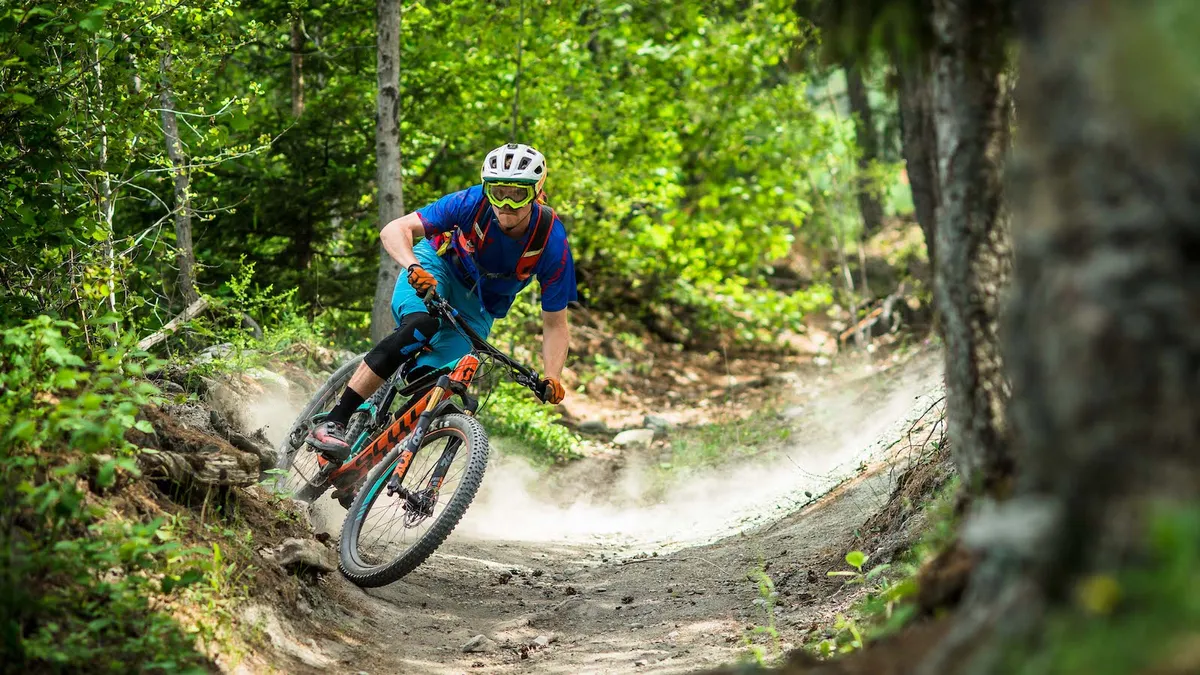
When descending, I had an issue with bar height. I didn’t mind the shape of the one-piece bar, but they simply didn’t have enough rise for me. I measured the bar height (which was set to its maximum) at around 104cm. For a bike with this BB height and reach, I’d normally want about 107cm or so.
At 6’3” I like a pretty high bar, so this is not an issue everyone will face, but with a longer reach comes the need for a higher bar, so I won’t be the only one to have this issue. If I was testing this bike at home, I would swap to a higher rise bar pretty quick.
As a result, I struggled to get enough pressure on my front tyre on steep descents and felt unable to ride aggressively in tight corners. The short back-end and long front-centre may be part of the reason I couldn’t weight the front wheel on my XL test bike, but without riding it with a higher bar I can’t say to what extent this played a role. Smaller frame sizes will have a less rearward weight balance too, as the rear-centre is the same for all sizes.
As a flip side to the short back-end, this bike certainly is lively. The long wheelbase doesn’t make it feel even a little bit ungainly — it’s very easy to manual, change lines, accelerate and hop about.
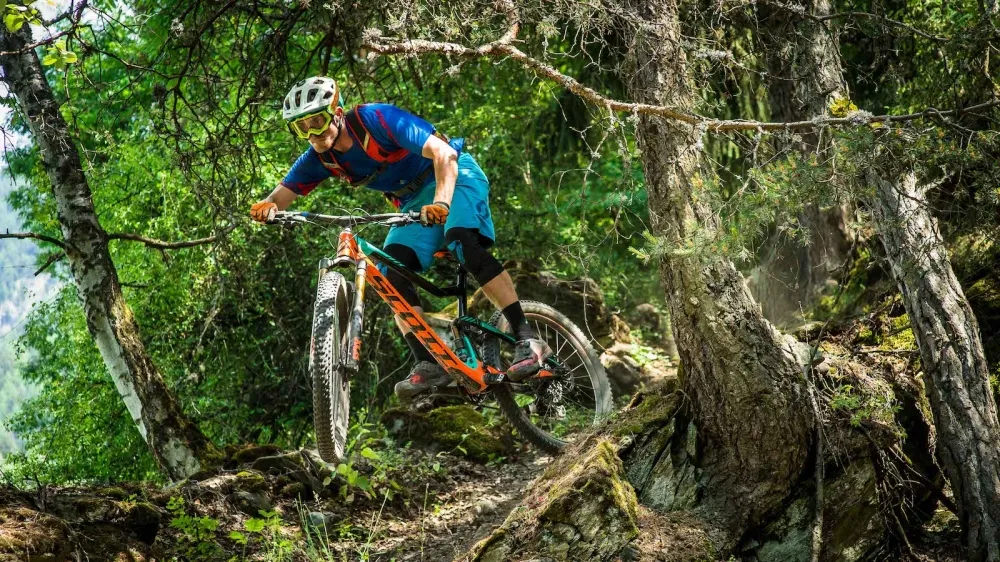
The thin-sidewall undamped Rekon+ tyres and super low overall weight made the bike feel a little fidgety in certain rough, loose and fast situations. As well as beefier tyres, I actually think I would benefit from having a little more weight on the frame to calm things down when it gets really rowdy. Despite the travel on offer, this is designed and spec’d out to be a fast and efficient trail bike, not an enduro sled.
I tested both the 29 x 2.6” wheels and the 650b x 2.8” options. The fatter tyres seemed to outweigh the benefits of the bigger diameter wheels in terms of traction, comfort and roll-over, as they allow you to get away with slightly lower tyre pressures.
I also found the high setting (used in combination with the smaller wheels) steepened the seat angle a little, making seated climbs a little easier. I tried both the high and low settings with the 650b wheels, the low setting caused me to clip pedals a little too often, though the stability was superb. Fortunately, the Genius is pretty slack and low even in the high mode.
The suspension is genuinely progressive and well-balanced front and rear too. This keeps the bike responsive to pedalling, pumping and cornering forces, while staying active and supple at the start of the travel.
Some riders may want to fit a smaller volume spacer to get a more forgiving ride, but for me, the progression was near-perfect off the shelf. And that’s a rare thing.
Pricing and availability for the Genius, which will be available in seven different builds, is yet to be released. See www.scott-sports.com for more info.

